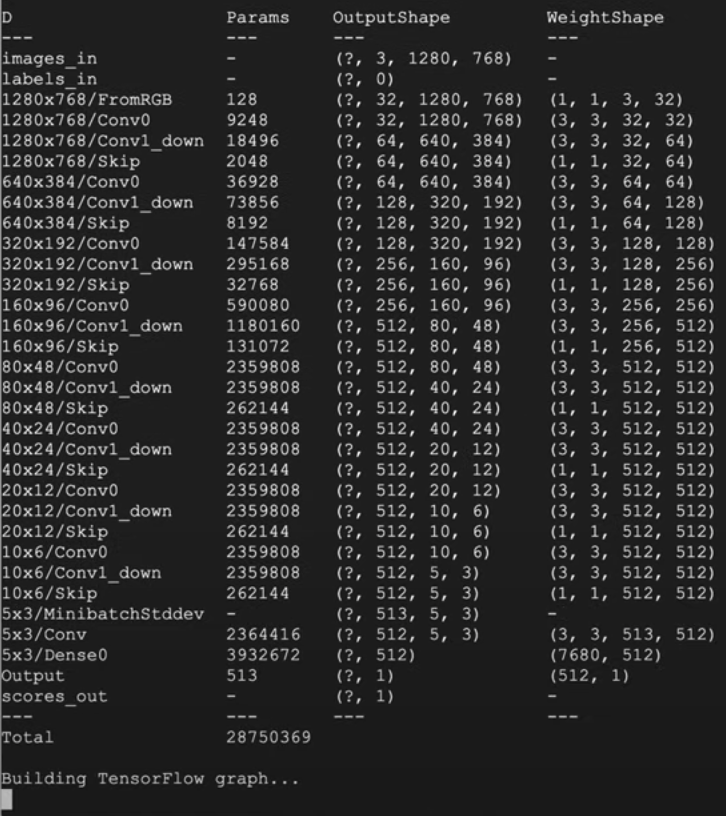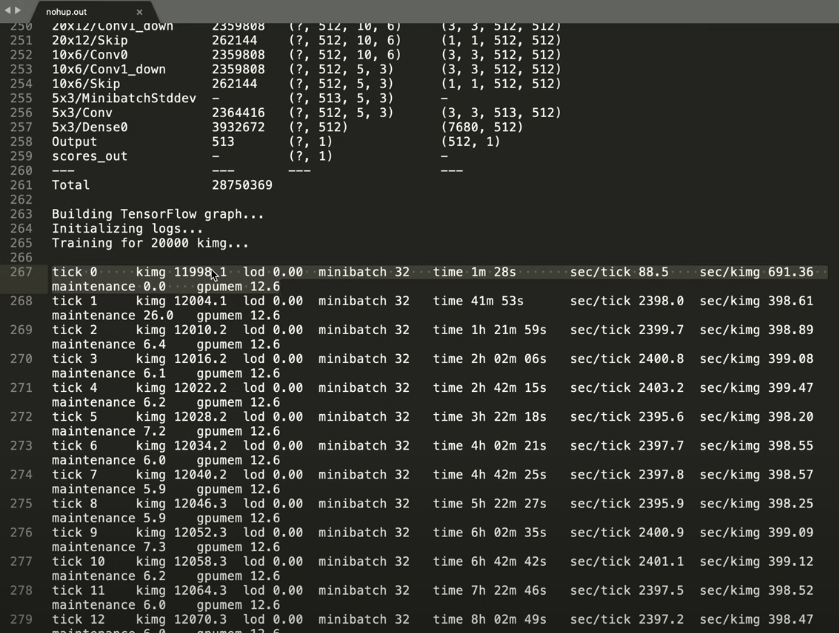#stylegan2 #non-square #gcp
Notes 📝 based on Training StyleGAN2 Part 2 Video 🎥 taught in the StyleGAN2 DeepDive course 📚by @Derrick Schultz and @Lia Coleman. The asterisk * on each numbered section will link to the video timecode of the tutorial.
1. Start-up Server ⚙️ *
- Login into GCP
- Click launch on your Compute account. (image?)
Notes:
- Have your dataset ready and uploaded in 📁Google Drive.
- Vertical 🎨 Images: 767px by 1200px
- Square 🎨 Images: 1024px by 1024px
- Refer to the Github
 repo skyfkynil/stylegan2 for detailed directions.
repo skyfkynil/stylegan2 for detailed directions. - For further information refer to the paper Official TensorFlow Implementation with practical improvements 📄http://arxiv.org/abs/1912.04958
2. SSH Login Open in Browser Window 💻 *
-
Click Login through SSH Connect, opening a browser window.
- Out of the box doesn’t have static IP (It can be set-up)
3. Activate StyleGAN2 library 🐍 *
- In Terminal activate your anaconda environment.
conda activate stylegan
4. Set-up Dataset Folder 📁 *
- Move into the skyflynil folder and go into the folder datasets
- Place all TFRecords in the datasets folder.
- Create raw_datasets folder
mkdir raw_datasets- (Why? To differentiate raw images from tfrecord folders)
- Go inside your new folder
cd into raw_datasets
5. Upload Dataset images in GCP ⬆️ *
- Use GDown
- Pass the ID to a file
- On GDrive, toggle Share linking on and copy the ID
gdown --id id-ofyour-gdrive-zip-file- GServer to GServer is really fast
6. Unzip 🔐 *
- Unzip your gdown file
unzip dataset-name.zip - Clean up your raw_dataset folder by removing the zip file
rm dataset-name.zip
- Go back to the main styleGAN2 folder
..//
7. Create our TFRecords files 🔮 *
- Create TFRecords from your image files, rather than training from raw-images (optimization)
!python dataset_tool.py create_from_images_raw --res_log2=8 ./dataset/dataset_name ./raw_datasets/dataset-name/- you should see raw-dataset TFRecords file
- (base) stylegan-ver: 1
Notes
-
Detailed instruction for training your stylegan2 skyflynil notes
-
Instead of image size of 2^n * 2^n, now you can process your image size as of (min_h x 2^n) X (min_w * 2^n) naturally. For example, 640x384, min_h = 5, min_w =3, n=7. Please make sure all your raw images are preprocessed to the exact same size. To reduce the training set size, JPEG format is preferred.
-
For image size 1280x768 (hxw), you may choose (min_h, min_w, res_log2) as (10, 6, 7) or (5, 3, 8) , the latter setup is preferred due to deeper and smaller network, change res_log2 argument for dataset creation and training accordingly.
-
-
For information on installing your anaconda environment check out the video StyleGAN2 installation on GCP 🎥
-
Documentation link to listing out your anaconda environments on Terminal
8. Upload & Transfer Learn from a new model 📙 *
- If your dataset are 🎨 images with dimensions 1200px by 768px, or 768px by 1200px (non-square) you must transfer learn from a model trained on those dimensions.
- The model that is default set in transfer learning is 1024px by 1024ox.
- You can't transfer learn if the size of your model and the size of your dataset don't match.
- Setup Results Folder 📁 to Ignore ("rename") 🚫 Square Model *
mv results/00000-pretrained/network-snapshot-1000.pkl results/00000-pretrained/network-snapshot-1000.pkl-ignore
- Get the sharable link to your non-square model pre-trained .pkl file on Google Drive and Gdown the file into the results folder.
gdown --id id-ofyour-pkl-file
9. Train Model ⚙️ *
!python run_training.py --num-gpus=1 --data-dir=./dataset --config=config-f --dataset=your_dataset_name --mirror-augment=true --metric=none --total-kimg=20000 --min-h=5 --min-w=3 --res-log2=8 --result-dir="/content/drive/My Drive/stylegan2/results"
Notes
- data-dir should always point to the parent of your parent directory of your TFRecords folder.
- config use config-e (512px) or config-f (1024px), it depends on the size of the image your are outputting to.
- dataset input the name of your dataset folder 📁
- total kimages 20000
- res-log2 means it is a power of 2
- so the model will multiply log2-8 by min-width=5 and min-height=2
- which gives us our 1280px by 768px training dimensions.
- width: 2^6*2 = 768
- height=2^8*5 1200
- This repo recommends that if you are doing 128 it recommends you use 7
- Because that 8th channel although it makes the network a little bit deeper it makes it smaller overall
⚠️ You can’t do a 16:9 or 720p aspect ratios.
10. Check on Your Training 👀 *
Notes:
- We are ready to start training, it will display that is is training from your last 🌵 .pkl file
- Its might be a bit slower the first time on the same machine because it is caching some files.
- Data shape = [3, 1280, 768] 📐
- Dynamic range = [0, 255] 🚥
- Range 0-255 256 the size that we can work with loading networks
- Custom Cuda commands compile
- (2- 5 minute wait) 🕓
- Outputting the architecture
 3. To confirm ✅, terminal should output process above 👆
3. To confirm ✅, terminal should output process above 👆
- Building Tensorflow graph
- Training for 20 kimages
- You will produce an initial 🌵 .pkl file from its current status.
- Outputting pickling up from the same image
- Size of the mini-batches
- Size of gpumem is how much memory the training is using. (underestimates)
- Warning:
⚠️ might throw error if the datasets TFRecords file is not the right shape.
11. Create Training Subprocess 🔗 *
- GCP terminal when closed, also terminates the training process.
- Nohup re-running the script using Nohup is a background process in the GPU that will allow us to close the browser window and continue the training process.
- Other solutions: Install gnu, gmux
- Now we will check nohup.out to asses wether this is working as a background process.
Nvdia-smi
- Cuda version 4.0
- How much GPU are you using
- Process ID python 15.7gb
- This is your command running on the GPU
Kill -9 PID number
- 24 hours of training later 🕓
- In GCP head back to your server into the skyflynil folder 📁
- Since nohup has made the training run as a subprocess you will have to type the Nvdia-smi command to check that it is running properly
Nvdia-smi
- Terminate the sub-process
ls results
- Head inside the results folder which will have the results labeled with your dataset name.
cd/results/0003-stylegan2-your_dataset_name
- Training 80k images can start reflecting dataset ok enough.
- Training up to 500k images gets to a really good point
- Truncation values will vary in displayed results.
14. Download file ⤵️ nohup.out 📑 *
- Download the nohup .out file
ls pwd
 2. Open in Text Editor and scroll to the bottom
2. Open in Text Editor and scroll to the bottom
Notes:
- A tick is a certain number of kimages, depending on what you set your mini-batch too
- How long does it take to train a tick faster with how quickly it takes
Hope these notes help to breakdown the StyleGAN2 video tutorial for reference in the future. 🚀




